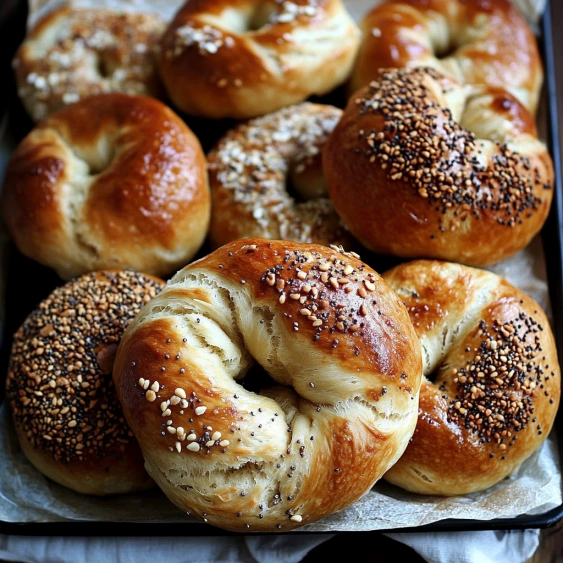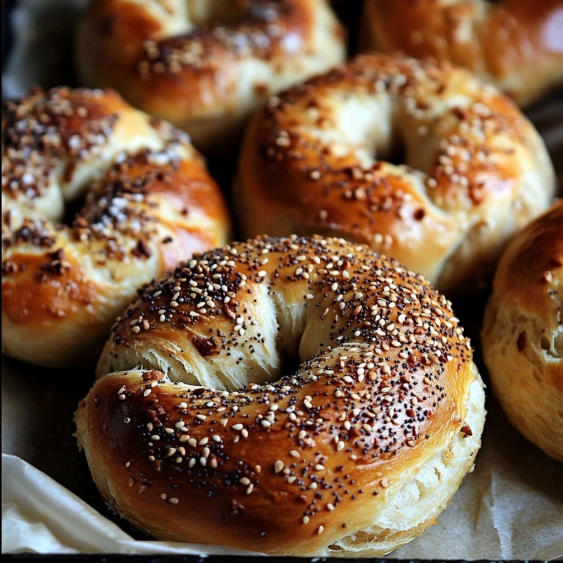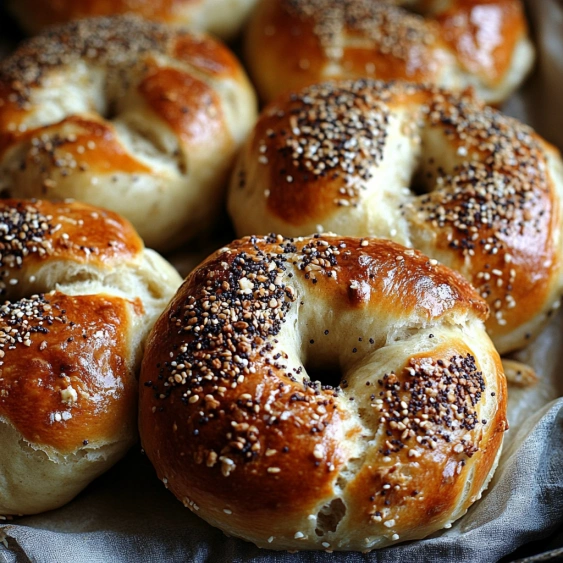 Pin it
Pin it
This foolproof bagel recipe creates that perfect chewy texture with a glossy crust you'd expect from your favorite bagel shop. After years of trial and error, I've simplified the process to create bakery-quality bagels right in your home kitchen without any specialized equipment.
I discovered this method during a snowstorm when I couldn't get to my local bagel shop. After that first batch, my Saturday morning bagel runs became a thing of the past. My kids now join me in the kitchen for our weekend bagel-making ritual.
Ingredients
- Bread flour or all-purpose flour: Provides the necessary structure and protein content for that signature bagel chew
- Diamond Crystal kosher salt: Balances the flavor without making the bagels taste salty
- Instant yeast: Eliminates the need for proofing and activating
- Lukewarm water: Hydrates the dough properly without killing the yeast
- Barley malt syrup: Gives that authentic bagel shop flavor and beautiful color to the crust
- Neutral oil: Prevents the dough from drying out during the long refrigeration
- Egg wash: Creates that signature glossy finish on your bagels
- Toppings of choice: Allows for personalization and variety
Step-by-Step Instructions
- Prepare the dough:
- Combine the dry ingredients in your food processor or stand mixer. Whisk together the water and barley malt syrup in a separate bowl. Add the liquid to the dry ingredients and immediately blend for 60-90 seconds. The immediate processing prevents the flour from absorbing too much water too quickly. Watch carefully for any sign of the blade jamming and stop immediately if it does.
- Form and refrigerate:
- Transfer the sticky dough to an oiled bowl with oiled hands. Stretch the dough up and down to form a ball, creating tension in the surface. Lightly oil the surface of the dough to prevent a crust from forming. Cover and refrigerate for at least 12 hours. This slow fermentation develops flavor and structure.
- Prepare for baking:
- Bring a large pot of water to simmer and add about ¼ cup of barley malt syrup. Preheat your oven to 425°F and line baking sheets with parchment paper. Prepare your egg wash and set out your desired toppings in shallow bowls for easy dipping.
- Shape the bagels:
- Turn the chilled dough onto a lightly floured surface. Divide into equal portions weighing about 105-110g each. Form each piece into a tight ball using the pinky edges of your fingers to create tension. Poke your thumb through the center and stretch the dough outward and under to form the classic ring shape. Be aggressive with the stretching to prevent cone-shaped bagels.
- Boil the bagels:
- Drop four bagel rings into the simmering malt water mixture. Boil for exactly 30 seconds on each side. The boiling creates that distinctive chewy exterior and sets the shape. Transfer to a towel-lined sheet to briefly drain.
- Top and bake:
- Brush each boiled bagel with egg wash. Dip the tops into your chosen toppings and arrange on the parchment-lined baking sheets. Bake for 20-25 minutes until evenly golden all around. Allow to cool on the baking sheets before slicing.
 Pin it
Pin it
I find that barley malt syrup makes the biggest difference in creating that authentic bagel shop flavor. The first time I used it instead of honey, my husband actually asked if I had secretly purchased the bagels from our favorite shop. That moment convinced me never to substitute this ingredient again.
Storage Solutions
These bagels keep well at room temperature in a paper bag for about 24 hours before they begin to lose their fresh-baked quality. For longer storage, slice the completely cooled bagels and freeze them in a ziplock bag with as much air removed as possible. To enjoy, toast directly from frozen without thawing first.
Troubleshooting Common Issues
If your bagels deflate after boiling, your dough likely needed more kneading to develop adequate gluten structure. The boiling water temperature matters too - a gentle simmer rather than a rolling boil prevents misshapen bagels. Remember that bagel dough should feel firmer than regular bread dough, so resist the urge to add more water during mixing.
Topping Suggestions
While everything bagel seasoning remains the most popular choice, consider branching out to create a variety platter. Cinnamon sugar works beautifully for a sweeter option, while za'atar provides a Mediterranean twist. For a deluxe version, try pressing caramelized onions into the top before baking. My personal favorite combination is sesame seeds with a light sprinkle of flaky sea salt.
 Pin it
Pin it
The History Behind Your Breakfast
Bagels originated in the Jewish communities of Poland in the 17th century before immigrating to North America with Jewish families. Traditional bagel making was considered an art form with apprentices studying for years to perfect the technique. The distinctive hole served a practical purpose - allowing bakers to thread the bagels onto dowels for easier transport and display at markets.
Frequently Asked Questions
- → Can I use all-purpose flour instead of bread flour?
Yes, you can use all-purpose flour, though bread or high-gluten flour will yield a chewier texture that's more characteristic of traditional bagels. The recipe specifically lists all-purpose as an option, but bread flour will provide that professional bagel shop quality.
- → Why do bagels need to be refrigerated overnight?
The cold fermentation in the refrigerator develops flavor complexity and improves the texture of the bagels. This slow rise allows the gluten to develop properly and creates those signature air pockets, resulting in bagels with better chew and taste.
- → What's the purpose of boiling bagels before baking?
Boiling sets the crust and creates that distinctive chewy exterior bagels are known for. The brief boil in water with barley malt syrup gelatinizes the surface starches, creating a barrier that allows the bagels to rise in the oven while maintaining their dense, chewy interior.
- → Can I substitute the barley malt syrup?
Yes, the recipe offers maple syrup or honey as alternatives to barley malt syrup. While barley malt provides the most authentic flavor, the others will work well. The sweetener contributes to browning and adds subtle flavor to both the dough and the exterior during the boiling process.
- → Why is the bagel shaping technique so important?
Proper shaping prevents bagels from puffing into cone-like shapes during baking. The aggressive pulling outward and under creates tension in the dough and establishes the classic bagel shape. Without this technique, the bagels won't maintain their proper ring form and may rise unevenly.
- → How should I store homemade bagels?
Freshly baked bagels are best consumed within 24 hours. Store cooled bagels in a paper bag at room temperature for 1-2 days. For longer storage, slice and freeze them in an airtight container for up to 3 months. Reheat frozen bagels directly in a toaster or thaw and then toast.
